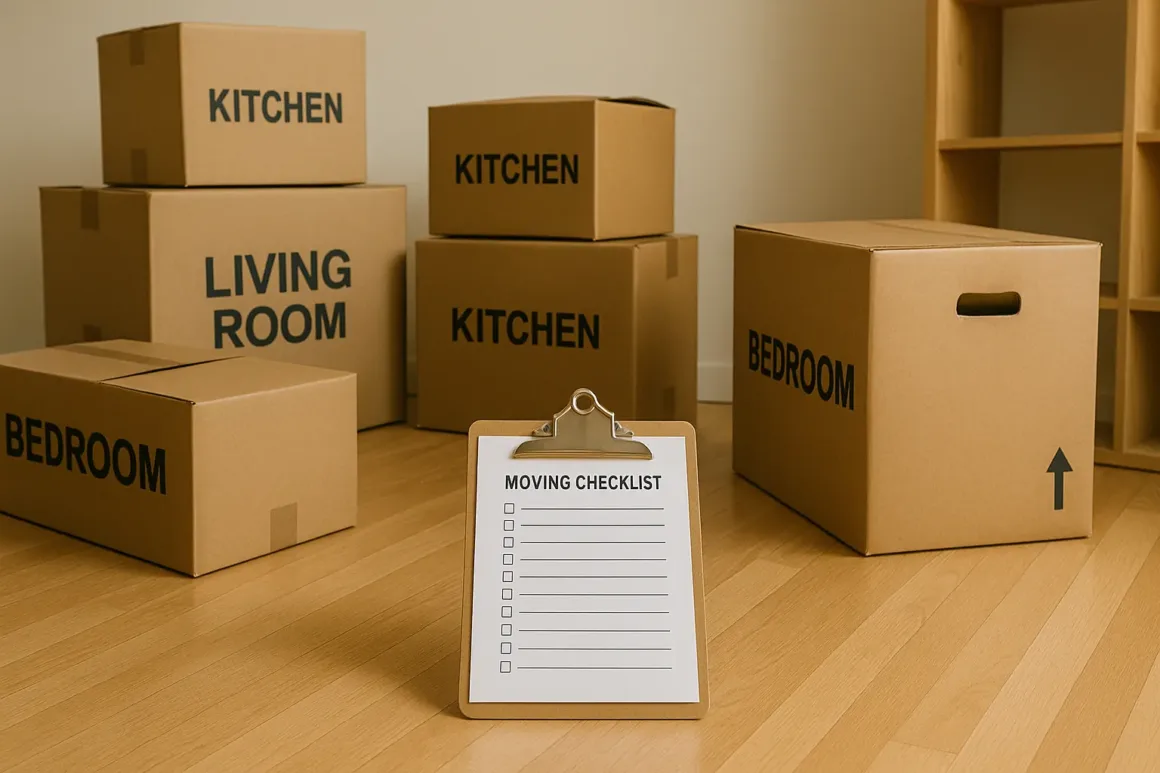Planning long distance moving this year? Beyond prices, you’ll need a clear plan for packing, protection, and delivery timing. More importantly, the right estimate type can prevent budget creep. In addition, verified carriers and a simple claims playbook cut stress. Finally, grab the downloads to stay organized from week 8 to move day.
Promise of this guide: You’ll understand what you’re paying for, how to protect your goods, which estimate protects your wallet, how to verify a mover, and which steps prevent 90% of damage and disputes.
Free Downloads (always current)
Keep the checklist, inventory, estimate, bill of lading, and valuation/insurance docs together in one folder or clipboard.
Contents
- Snapshot: What long-distance moving really costs
- Cost drivers you can actually control
- 8-week plan (checklist + scripts)
- Choosing an estimate (binding vs not-to-exceed)
- Coverage: valuation vs insurance (evergreen rules)
- Accessorials explained (with planning moves)
- Packing systems that prevent damage
- Route & timing playbook (any season)
- Move-day operations: load to delivery
- Claims & documentation workflow
- Compliance & scam-proofing
- Special cases: kids, pets, plants, older people, remote work, storage
- DIY truck vs containers vs full-service
- City→City routes & internal resources
- FAQ
- Glossary

Long Distance Moving Costs (by distance & home size)
Use these evergreen ranges as a starting point. Real quotes vary with inventory, route, seasonality, and access.
| Distance | Studio/1 BR | 2 BR | 3–4 BR |
|---|---|---|---|
| ≈500–800 miles | $1,200–$3,200 | $2,400–$5,200 | $4,800–$7,800 |
| ≈800–1,500 miles | $1,400–$3,800 | $2,900–$6,400 | $5,500–$9,800 |
| 1,500+ miles | $1,800–$4,400 | $3,600–$7,800 | $7,000–$10,500+ |
Deep dives: Long-Distance Moving Costs (soon) · Cheapest Time to Move (soon)
Evergreen tip: Prices trend higher in late spring/summer and lower mid-winter. Mid-week pickups are typically easier to schedule.
Long Distance Moving Cost Drivers You Can Control
Rates vary by inventory and access. However, you can influence several levers: scope clarity, elevator/curb reservations, and flexible delivery windows. As a result, quotes become comparable and usually cheaper.
- Scope clarity — Give each mover the same inventory, packing level, and delivery window.
- Access — Reserve elevators/curb space to avoid shuttles and long carries.
- Timing flexibility — A 3–5 day delivery spread is cheaper than a one-day guarantee.
- Packing choices — Self-pack some rooms, but use double-wall cartons and dish packs to preserve coverage.
- Weight pruning — Donate heavy, low-value items (books, worn furniture, bulk pantry).
For those relocating valuable or bulky furniture across states, Georgia Furniture Shipping services can provide specialized care and cost-efficient options tailored for southern routes.
Long Distance Moving Checklist: 8-Week Timeline
Download: 8-Week Checklist (PDF)
Long Distance Moving Week 8–7: Discovery & Documentation
- Shortlist movers or container providers; schedule a survey (virtual or in-home).
- Photograph high-value items (front/serials), record appraisals.
- Request quotes with identical scope and ask for the tariff excerpt with all accessorial rates.
Script (inquiry):
“We’re moving a 2-bed/1,000 sq ft apartment with elevator, no storage. Please quote not-to-exceed and include packing by room (if any), stairs/long carry/shuttle if applicable, and a 3–5 day delivery spread. Send the tariff section with packing and accessorial rates.”
Interstate Moving Week 6–5: Decisions, Dates & Permits
- Choose estimate type (see below); lock pickup window.
- Reserve elevator, loading dock, permits; confirm truck access at both ends.
- Order double-wall cartons, dish packs, wardrobe boxes, a tape gun, and labels.
Week 4–3: Packing Starts — Cross-Country Labeling System
- Pack non-essentials first; label two sides + top with room and contents.
- Maintain the Inventory (XLSX).
- Transfer utilities and insurance; request school/medical records.
Week 2–1: Final Prep for Long Distance Moving Day
- Photograph cable setups; bag remotes/screws per device.
- Stage a first-night kit (linens, cookware, toiletries, snacks, tools, meds).
- Confirm coverage selections and payment method.
Move week: Execute
- Clear load path, protect floors, and stage boxes by room.
- Count boxes leaving and arriving; note visible pre-existing damage on paperwork.
- Keep jewelry, documents, meds, and keys with you.
Interstate Moving Estimates: Binding vs Not-to-Exceed
- Binding — Price holds if inventory/services don’t change; any revision must be in writing.
- Not-to-exceed (aka “guaranteed not to exceed”) — You pay the lower of the estimate or the actuals. Great when the estimated weight is conservative.
- Non-binding — Ballpark only; not recommended for contract stage.
Reality check: A low number without accessorials, FVP, or delivery window details is not a deal—it’s a scope gap.
Guide + sample questions: Moving Estimates Explained (soon)
Cross-Country Moving Coverage: Valuation vs Insurance
- Released value (default) — Mover liability is often ≈ $0.60/lb per item. Minimal protection.
- Full-Value Protection (FVP) — Carrier repairs/replaces or cash-settles up to your declared value (e.g., $6/lb × total weight). Ask about deductible tiers.
- Third-party insurance — A separate policy that may cover exclusions outside mover liability.
Compare options: Valuation vs Insurance (soon)
Evergreen tip: Claims succeed when you have before/after photos, serials/appraisals, and a clean inventory line that matches the bill of lading.
Accessorials in Long Distance Moving (definitions & typical ranges)
| Item | What it is | Typical pattern | Planning move |
|---|---|---|---|
| Shuttle | Smaller truck used when tractor can’t access | Flat or hourly; adds handling | Reserve curb space; confirm street width & dock timing |
| Long carry | Door-to-truck distance beyond allowance | Charged per 75–100 ft | Stage near entrance; request closest legal parking |
| Stairs/Elevator | Flight counts or slow elevator | Per flight or hourly | Book elevator; ask for exclusive window if possible |
| Packing | Pro packing of boxes/crates | Per box + materials | Self-pack stable items; let pros pack glass/china |
| SIT | Storage-in-transit | Monthly + handling in/out | Align lease dates; use containers if flexible |
Long-Distance Packing Tips that Prevent 90% of Damage
Principles (physics never changes):
- Dense + immobile: no voids, no rattles.
- Weight on weight: heavy items in small boxes; light items in large boxes.
- Edge + corner protection: use furniture pads + corner guards; stretch wrap over pads.
- Moisture & dust: mattress bags sealed, wardrobe boxes for hanging clothes.
- Electronics: original boxes best; otherwise double-box with antistatic/bubble; bag all small parts.
Get the full method: Pro Packing for Long-Distance Moves (soon) · Inventory (XLSX) · Labels (PDF)
Route & timing playbook (any season)
- Shoulder seasons (early spring, late fall): solid balance of price and availability.
- Peak (late spring–summer): book 6–8+ weeks ahead for 2–4 BR homes.
- Winter: lower rates but more weather risk—pad timing and protect floors/entrances from melt & grit.
- Mid-week pickups: typically easier to schedule than weekends.
- Delivery spreads: a 3–14 day window is common cross-country; tighter windows cost more.
Move-day operations: load to delivery
Delivery spreads are common on cross-country routes. Even so, note visible damage on the receipt before signing. After that, submit photos and inventory lines with your claim to speed resolution.
- Walkthrough & counts — Confirm box count and inventory tags; photograph major pieces.
- Protection — Floor runners, door jamb guards; call out fragile pieces.
- Bill of lading — Verify legal name, DOT/MC, pickup/delivery addresses, and coverage selection.
- At delivery — Check counts; note visible damage on the delivery receipt before signing; keep a photo of the signed copy.
Claims & documentation workflow
- Start early — Open a claim as soon as you see damage.
- Evidence packet — Before/after photos, serials, appraisals, purchase docs, inventory lines, and delivery receipt notes.
- Communication — Keep all emails in one thread; summarize phone calls by email the same day.
- Resolution paths — Repair, replace, or cash settlement per valuation or policy terms.
Compliance & scam-proofing
- Identity match — The estimate shows the same legal name, address, and phone as on the bill of lading and trucks.
- Numbers — Ask for DOT/MC identifiers in writing.
- Tariff access — Request the relevant tariff pages showing accessorial and packing rates.
- Money hygiene — Avoid large cash deposits or wire-only requests.
- Carrier vs broker — Ask who performs the move and where goods sit between legs.
More: Avoid Moving Scams (soon)
Special cases: kids, pets, plants, older people, remote work, storage
- Kids — Keep routines; involve them with safe labeling; stage a comfort kit. See: Moving with Kids (soon)
- Pets — Crate acclimation; vet records; temperature management on travel days. See: Moving with Pets (soon)
- Houseplants — Pack to prevent crushing; avoid temperature shock; acclimate on arrival. See: Moving with Houseplants (soon)
- Older adults — Add extra time buffers; prioritize medication access and first-night comfort; minimize trip hazards.
- Remote work setups — Photograph cable routing; pack peripherals by station; test internet on arrival day one.
- Storage-in-transit or containers — Inventory carefully; keep “open first” boxes separate.
Long Distance Moving Options: DIY Truck vs Containers vs Full-Service
| Option | Best for | Watch-outs |
|---|---|---|
| DIY truck | Lowest cash; short/medium routes; lighter loads | Driving fatigue, fuel/tolls, lodging, weather |
| Containers | Load at your pace; built-in storage | Transit variability; multiple units for larger homes |
| Full-service | Least effort; large homes; tight schedules | Highest cash cost; peak-season availability |
Calculator & guide: DIY vs Pods vs Full-Service (soon)
City→City routes & internal resources
- NYC → Austin (soon)
- Los Angeles → Seattle (soon)
- Chicago → Phoenix (soon)
- Boston → Miami (soon)
More hubs: Long-Distance Moving Costs (soon) · Pro Packing (soon) · Avoid Scams (soon)
Next step: Compare 2–3 protected quotes from vetted long distance relocation experts (partner link)—ask for not-to-exceed or binding terms, Full-Value Protection, and all accessorials in writing.
Affiliate & Sponsorship Disclosure
We sometimes partner with vetted moving companies and providers. If you click a partner link, we may earn a commission at no extra cost to you. Our recommendations are based on scope clarity, legal compliance (DOT/MC), coverage options, and customer support—not payments.
FAQ
Peak season: 6–8+ weeks for 2–4 BR homes. Shoulder/off-season: 3–6 weeks.
Mid-week (Tue–Thu) is typically easier and cheaper to schedule.
Coverage can be limited under valuation/policies. Pack professionally and document condition.
Linens, towels, basic cookware, snacks, toiletries, meds, chargers, tool kit, box cutter, kids/pets comfort items.
Glossary
- Bill of lading (BOL) — Your move contract; shows services, dates, and liability election.
- FVP (Full-Value Protection) — Carrier liability up to your declared value; repair/replace/cash.
- Released value — Default minimal liability (≈$0.60/lb per item).
- Tariff — The carrier’s schedule of rates and rules.
- Shuttle/long carry — Accessorials triggered by limited truck access or distance to the door.
- SIT — Storage-in-transit at a carrier facility.
Author: Perla Irish
Reviewed by: Independent Certified Moving Consultant (CMC)
Evergreen — Last comprehensive review: 2025-10-08
More tools: Long-Distance Hub (soon) · Downloads
Perla Irish, who is more familiarly known as Irish, is the Content Manager at newfld.com. She loves following trends around home and garden, interior design and digital marketing. Through this blog, Irish wants to share information and help readers solve the problems they are experiencing.
